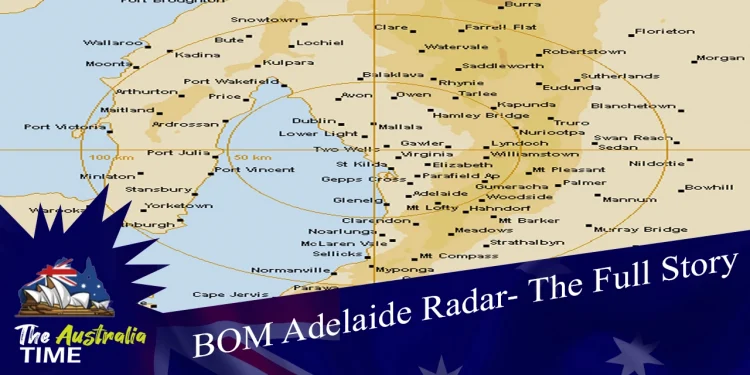The Meteorology Act 1906 created the BOM on January 1, 1908.
Before the Federation in 1901; Every region had its own meteorological office, one of which is BOM Adelaide. In August 1905, federal home affairs minister Littleton Groom inspected state governments; finding South Australia and Victoria unlikely to give responsibility.
In April 1906, state governments decided to hand over meteorology and astronomy to the federal government. Groom opposed a takeover of astronomy owing to its connections to universities governed by state law.
Locations Of Bom Adelaide Radar
Adelaide (Buckland Park)
The first BOM Adelaide radar locates at Buckland Park, Adelaide. Meteor 1500SDP Dual Polarization Radar (S-Band, 10 cm wavelength).
24 hours a day, 7 days a week.
Geographical Positioning
On the coastal plain, 35 km north-northwest of Adelaide, is the radar. It runs from Burra to Cape Jervis, and it is the Mount Lofty Peaks; it’s the region’s major topographic feature.
To the east and southeast of the ranges; rain drizzles may impair the radar’s view. Otherwise, coverage is restricted by the distance between the radar and the earth’s curvature.
Aspects Of BOM Adelaide Weather
Typically, rain-bearing weather systems approach bom Adelaide forecast from the western half of the skyline; from the southwest to the north.
Buckland Park’s radar station is well located to detect and monitor these systems. While the Mount Lofty Ranges may conceal Bom radar Adelaide views thin rain showers on the eastern side of the ranges. Heavier rain and thunderstorms may observe in this location.
Non-Meteorological Echoes
While processing the radar data usually eliminates persistent echoes created by hills, buildings, and other solid objects. These manifest as tiny, stationary areas of light rain, primarily along the Mount Lofty Ranges’ upper elevation.
Under stable atmospheric circumstances particularly when low-level temperature inversions exist; anomalous propagation may result in patches of echoes appearing over;
- Yorke Peninsula’s eastern coastline
- The southern Gulf St Vincent
- Sections of Kangaroo Island
- The Fleurieu Peninsula
When the waves in the Gulf of St Vincent are extremely stormy. Some sea clutter may be observed in the west and southwest sectors, out to around 30 kilometers. Since this marine clutter tends to stay in one location.
It may distinguish from rain echoes, which often travel with the wind.
Adelaide (Sellicks Hill)
Second BOM Adelaide radar Sellicks Hill locates roughly 45 kilometers south of Adelaide Airport. The type is WF 100 (C-Band, 5-centimeter wavelength) 24-hour availability.
Geographical Positioning
Sellicks Hill radar is perched on an escarpment that forms part of the Mt Lofty Ranges’ southern extension.
From Burra to Cape Jervis, the ranges run generally north to south. But the cliff on which Sellicks locates is oriented northeast to southwest. The elevation of the radar antenna is approximately 350 meters above sea level.
Aspects Of BOM Adelaide Weather
The majority of rain-bearing weather systems approach from the western part of the skyline;mostly from the southwest to the north.
Sellicks Hill radar is at an optimal location for detecting and tracking these devices. Shallow rain showers or drizzle can also be spotted on the eastern side of the Mount Lofty Hills; as the radar is not covered by the ranges. If there are huge thunderstorms nearby; the “C Band” radar will not be able to detect storms behind the nearest storms.
This will also result in an underestimate of the power of extremely violent solitary storms at times. Rainfall directly above the radar will diminish the radar’s dependability in all directions.
Echoes That Are Not Meteorological In Nature
If there is a breeze, partial beam reflection from waves on Gulf St Vincent (5 km to the west); results in a quasi-permanent weak echo region stretching from around 315°F to 240°F.
This is distinct from true echoes, which are smaller in size and typically exhibit constant motion. The Sellicks Hill radar is becoming progressively impacted by the development of trees on the adjacent slope.
This development is most evident when the vegetation is moist; is obstructing the radar beam in locations to the northeast through the southwest. When analyzing Sellicks Hill radar data in these quadrants, caution should be exercised. And cross-referencing the data to Buckland Park radar images is suggested.
What Is Bom Adelaide Forecast For This Week?
The forecast for the following week is as follows for additional updates;
please visit the MOB Adelaide forecast:
Forecast for Monday
Cloudy with a chance of rain.
Showers are likely 40% in the northern suburbs but are unlikely 20% elsewhere.
Winds from the south to the southeast at 15 to 25 km/h.
Tuesday, April 19th
Partly Cloudy.
In the morning, there is a slight 20% possibility of showers.
Winds 15 to 25 km/h south to the southwest; becoming westerly in the afternoon and evening.
Wednesday, April 20th
Partly Cloudy.
Showers are likely in the morning at 50%.
Winds 15 to 25 km per hour west to the northwest; turning southwest in the morning and becoming light southeast in the evening.
Thursday, April 21st
Partly Cloudy.
Showers are possible at 20% in the hills and southern suburbs. In the afternoon, light winds becoming southeast at 15 to 25 km/h.
Friday, April 22nd
Partly Cloudy.
Southeast winds 15 to 25 km/h.
Saturday, 23rd April
Cloudy with a chance of rain.
Southeast winds 15 to 25 km/h.
Sunday, April 24th
Partly Cloudy.
Showers are only a slight 20% possibility. Southeast winds 15 to 25 km/h shift to the east during the morning.
Monday, April 25th
Partly Cloudy. Showers are only a slight 20% possibility.
East winds 15 to 25 km/h.
Stay connected with us for more latest updates and news all the time: The Australia Time.
















